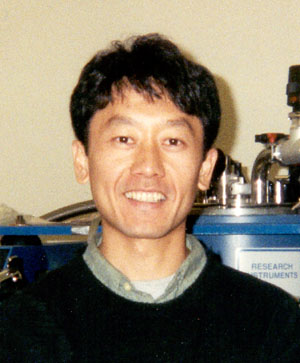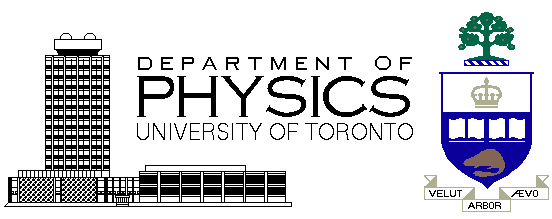|
John
Y.T. Wei
Associate
Professor
Condensed Matter Physics |
|
 |
|
|
Scholar, Canadian
Institute
for Advanced Research (since 1999)
Member, Brockhouse Institute for Materials Research (since 2003) Member, Center for Quantum Information and Quantum Control (since 2004) Postdoctoral Scholar & Senior Research Fellow, California Institute of Technology (1996-99) Joint Research Student, IBM T. J. Watson Research Center (1992-95) M.S. & Ph.D., Columbia University (1991 & 1996) B.A., University of California Berkeley (1987)
Research
Interests: Nanoscale studies of exotic superconductors
& magnets,
high-temperature
&
heavy-fermion superconductivity,
colossal magnetoresistance, spin-injection & phase-slip phenomena. Materials: Cuprates, intermetallics, manganites, superconducting & ferromagnetic nanostructures. Techniques: Cryomagnetic scanning tunneling microscopy (STM), quasiparticle tunneling & Andreev reflection spectroscopy, pulsed laser deposition (PLD), electron beam lithography. My
research is devoted to nanoscale studies of novel electronic materials,
using both top-down and bottom-up experimental approaches. These
materials are so-called quantum materials where quantum mechanical
effects of electrons are manifest. They incldue exotic superconducting
cuprates, ferromagnetic manganites and thin-film
heterostructures
comprising these novel materials. These materials are remarkable
in that they are characterized by strong electron-electron
correlations,
share a similar perovskite crystal structure, but exhibit extremely
different
physical behaviors depending on the chemical composition. These
experiments
are intended to study the fundamental problems of high-temperature
superconductivity,
half-metallic ferromagnetism and their dynamic interplay.
For the cuprates, I am primarily interested in the symmetry of the Cooper pairs, which can be determined by measuring the anisotropy of quasiparticle tunneling and Andreev reflection spectroscopy, as a means to elucidate the microscopic mechanism underlying high temperature superconductivity. Because of the short superconducting coherence length (<10nm) in the cuprates, it is important to probe these pairs locally. A complex pairing symmetry, such as d+is or d+id', could provide a locally phase-coherent and naturally doubly-degenerate system for use as a quantum computational bit, i.e. a superconducting QUBIT. And because the cuprates are known to have spatial inhomegeneities involving spin/charge separation, it would be very useful to be able to discern between spin and charge excitations, e.g. by using a tunable spin-polarized scanning probe. For the manganites, my focus is on the ferromagnetic double-exchange interaction which spin-polarizes the itinerant band electrons, and on how this half-metallic character affects the electrical conduction in a phenomenon known as colossal magnetoresistivity. It is important to probe the spin-polarized electronic spectrum locally and under quasiparticle injection, in order to understand the role of tunneling magnetoresistance between microdomains, and to determine the spin-diffusion length and spin-relaxation time scales which are vital to spintronic applications. By combining these lattice-compatible materials into superconductor/ferromagnet epitaxial heterostructures, with the ferromagnet serving as a source for spin-polarized quasiparticle injection, the dynamics of both Cooper pair-breaking in the cuprates and itinerant magnetism in the manganites can also be examined. Such studies could reveal important phenomenological links between the superconductivity and the magnetism which occur in the perovskite system. My experimental expertise involves the technique of scanning tunneling microscopy (STM), which provides a highly sensitive probe of the electronic density of states in conjunction with atomic-scale spatial resolution. Our current plan is to extend these STM spectroscopy measurements to ultra-low temperatures (below 100mK) and high magnetic fields (up to 18Tesla), using apparatus my students and I are expressly building for these purposes. We are studying both single-crystal and epitaxial-film samples, the latter to be grown by a multiple-target pulsed laser-ablated deposition (PLD) system which we have installed. The multilayer epitaxial films can also be patterned into nanostructures using electron-beam lithography facilities which we have also installed in-house . Courses
Taught Physics
1850F: Foundations of Condensed Matter Physics
Physics 225H: Undergraduate Laboratory Physics 281S: Introduction to Quantum Physics
Select Papers: Conductance characteristics
between a normal metal and a 2D Fulde-Ferrell-Larkin-Ovchinnikov
superconductor Point Contact Spectroscopy
Study of the Ferromagnetic Superconductor ZrZn_2 Evidence
for Current-Driven
Phase Slips in YBa_2Cu_3O_7-d Microstrips Nuclear Spin Relaxation
of 8Li in a Thin Film of La_0.67Ca_0.33MnO_3 Suppression of low-energy
Andreev states by a supercurrent
in YBa_2Cu_3O_7-d Spectroscopic Evidence
for Multiple Order Parameter
Components in the
Heavy
Fermion Superconductor CeCoIn_5 Selective epitaxial
growth of sub-micron complex oxide
structures by amorphous SrTiO_3 Scanning tunneling
spectroscopy under pulsed spin injection Nanoscale
high-temperature superconductivity Tunneling spectroscopy
study of spin-polarized
quasiparticle injection
effects in
Directional tunneling
and Andreev reflection on
YBa_2Cu_3O_{7-delta}
single crystals:
Predominance of d-wave pairing symmetry verified with the generalized BTK theory, J. Y. T. Wei et al., Physical Review Letters 81, 2542 (1998). |
|
| University of Toronto | |






